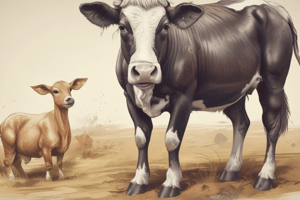Podcast
Questions and Answers
What is the primary purpose of castration in beef cattle?
What is the primary purpose of castration in beef cattle?
- To improve meat quality and tenderness (correct)
- To enhance wool production
- To increase breeding opportunities
- To reduce meat color
A non-surgical method of castration involves the use of a knife.
A non-surgical method of castration involves the use of a knife.
False (B)
What is the term used for a castrated horse?
What is the term used for a castrated horse?
Geld
Castration of a male chicken is referred to as _____ .
Castration of a male chicken is referred to as _____ .
Match the type of animal to its castrated name:
Match the type of animal to its castrated name:
Which of the following is a disadvantage of using the elastrator method?
Which of the following is a disadvantage of using the elastrator method?
Castration is performed on horse at 1-2 months.
Castration is performed on horse at 1-2 months.
What is the preferred age for castrating beef cattle?
What is the preferred age for castrating beef cattle?
Flashcards
Castration of Animal
Castration of Animal
Surgical removal of the testicles, or their destruction using non-surgical techniques, leading to atrophy.
Castrated Bull - Beef Cattle
Castrated Bull - Beef Cattle
A castrated bull, often called a steer, improved meat quality(tenderness and juicing) by this procedure.
Castrated Horse
Castrated Horse
A castrated male horse, called a gelding. To calm and prevent unwanted breeding.
Caponization
Caponization
Signup and view all the flashcards
Burrdizzo (emasculatome)
Burrdizzo (emasculatome)
Signup and view all the flashcards
Elastrator and Rubber Ring
Elastrator and Rubber Ring
Signup and view all the flashcards
Wether
Wether
Signup and view all the flashcards
Castration Methods
Castration Methods
Signup and view all the flashcards
Study Notes
Animal Castration: Definition
- Castration involves removing or destroying the testicles (surgical or non-surgical).
- Non-surgical methods lead to atrophy of the testicles while maintaining the scrotum intact.
Animal Castration: Indications
- Making the animal docile
- Facilitating management in the presence of females
- Preventing unwanted breeding
- Treating and correcting certain conditions
- Improving weight gain in livestock (meat animals)
- Increasing meat quality (tenderness and flavor).
Horse Castration
- Uncastrated horses are called colts.
- Castrated horses are called geldings.
- Castration for horses is performed by surgery.
- Optimal age for castration is 12-24 months.
- The goal is to calm the animal down.
Beef Cattle Castration
- Castrated bulls are called steers.
- Castration aims to improve meat quality (juiciness, tenderness, color).
- Preferred ages are 3-4 months, but any age can be castrated.
- Spring and fall are generally the best seasons.
- Castration methods include surgical (open) and non-surgical (closed techniques).
- Non-surgical methods involve tools like burdizzo, elastrator (rubber ring).
Burdizzo (Emasculatome) Technique
- This method crushes the spermatic cord and blood vessels.
- It helps stop bleeding (hemostasis).
- It doesn't cause scrotum sloughing.
- Application happens above the testicles (2-5 cm).
Elastrator and Rubber Ring Technique
- This is done on animals less than 1-2 months old.
- Blood circulation to the testicles and scrotum is cut off, resulting in atrophy and sloughing of the scrotum (3-4 weeks).
- Disadvantage: higher risk of tetanus or infection.
Sheep Castration
- Castrated sheep are called wethers.
- Aim: improve meat and wool quality.
- Preferred age: 2–4 weeks (2).
- Optimal seasons: spring and summer.
- Castration methods: surgical (bloody) or non-surgical (bloodless). Non-surgical methods include burdizzo, elastrator, knife, and emasculator.
- Knife-based methods can sometimes cause infections.
- Burrdizzo-based methods may lead to repeats.
Poultry Castration (Caponization)
- Castrated male chickens are called capons.
- Aims to improve meat quality (tenderness and juiciness).
- Average age: 2-4 weeks.
- Breeders must select strong, healthy birds.
- Pre-castration factors include good breed, health, vigor, appropriate age, lighting, and good restraint during the procedure.
- Caponization is a simple procedure but demands specialized care.
Method Comparison Table (Surgical Castration, Elastrator Rings, Burdizzo)
| Method | Advantages | Disadvantages |
|---|---|---|
| Surgical | Visual confirmation; sharp, disposable blades; inexpensive; development of scrotal sac enhances appearance and market price | Blood loss; risk of swelling and infection; higher workplace safety risk due to sharp blades; experienced operator needed |
| Elastrator Rings | Calves can be castrated at a young age; reduces stress; bloodless and no open wounds; less pain; inexpensive rings and applicators; older calves can be castrated well up to the age of six months | Highest tetanus risk; cannot be used on calves older than two weeks; no 'cod' formation; experienced operator needed |
| Burdizzo | Bloodless; no open wounds; appears to cause less pain than surgical castration; older calves can be castrated; less stress needed. | Needs experienced operator; equipment needed; Burdizzo emasculator expensive; cannot visually confirm if procedure is successful |
Studying That Suits You
Use AI to generate personalized quizzes and flashcards to suit your learning preferences.




